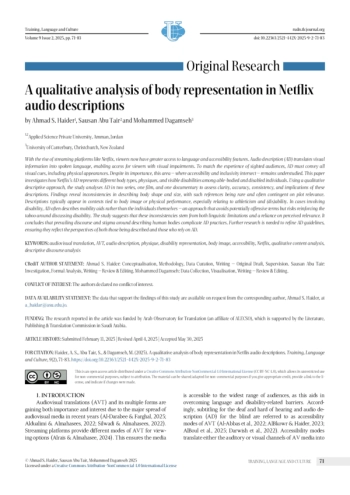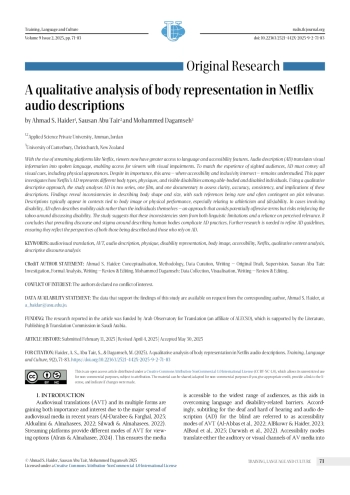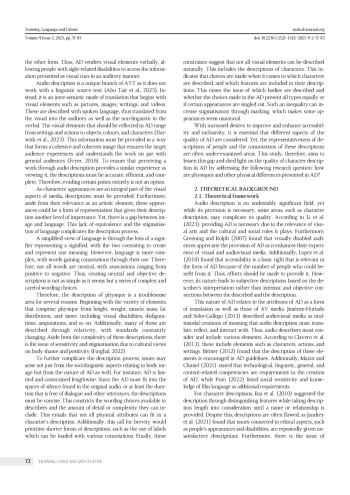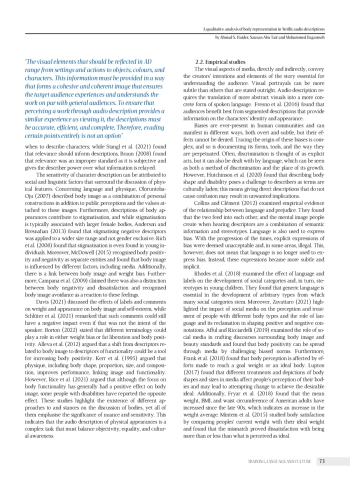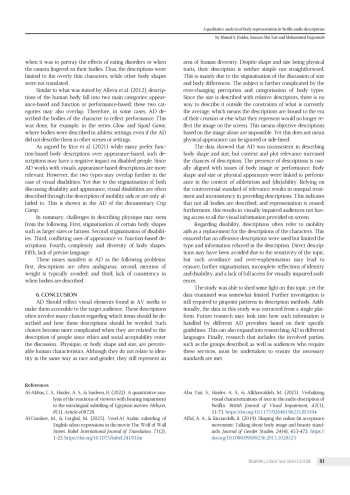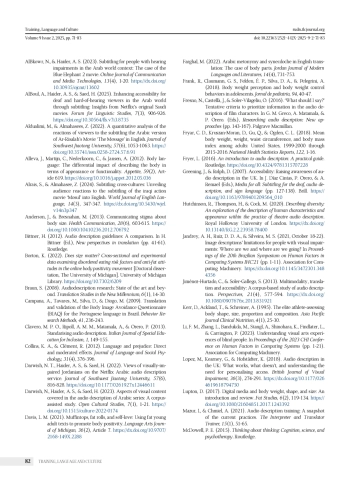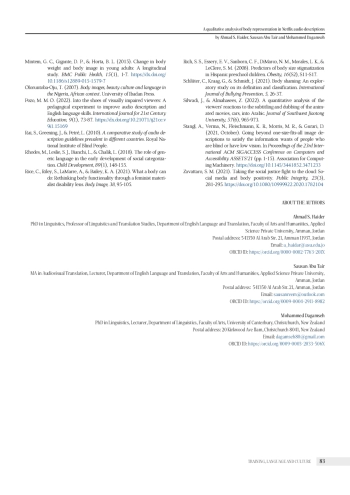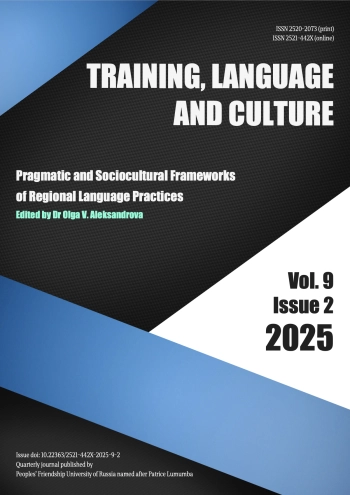With the rise of streaming platforms like Netflix, viewers now have greater access to language and accessibility features. Audio description (AD) translates visual information into spoken language, enabling access for viewers with visual impairments. To match the experience of sighted audiences, AD must convey all visual cues, including physical appearances. Despite its importance, this area – where accessibility and inclusivity intersect – remains understudied. This paper investigates how Netflix’s AD represents different body types, physiques, and visible disabilities among able-bodied and disabled individuals. Using a qualitative descriptive approach, the study analyses AD in two series, one film, and one documentary to assess clarity, accuracy, consistency, and implications of these descriptions. Findings reveal inconsistencies in describing body shape and size, with such references being rare and often contingent on plot relevance. Descriptions typically appear in contexts tied to body image or physical performance, especially relating to athleticism and (dis)ability. In cases involving disability, AD often describes mobility aids rather than the individuals themselves – an approach that avoids potentially offensive terms but risks reinforcing the taboo around discussing disability. The study suggests that these inconsistencies stem from both linguistic limitations and a reliance on perceived relevance. It concludes that prevailing discourse and stigma around describing human bodies complicate AD practices. Further research is needed to refine AD guidelines, ensuring they reflect the perspectives of both those being described and those who rely on AD.
Идентификаторы и классификаторы
Audiovisual translations (AVT) and its multiple forms are gaining both importance and interest due to the major spread of audiovisual media in recent years (Al-Darabee & Farghal, 2025; Aldualimi & Almahasees, 2022; Silwadi & Almahasees, 2022). Streaming platforms provide different modes of AVT for viewing options (Alrais & Almahasee, 2024). This ensures the media is accessible to the widest range of audiences, as this aids in overcoming language and disability-related barriers. Accordingly, subtitling for the deaf and hard of hearing and audio description (AD) for the blind are referred to as accessibility modes of AVT (Al-Abbas et al., 2022; AlBkowr & Haider, 2023; AlBoul et al., 2025; Darwish et al., 2022).
Список литературы
1. Al-Abbas, L. S., Haider, A. S., & Saideen, B. (2022). A quantitative analysis of the reactions of viewers with hearing impairment to the intralingual subtitling of Egyptian movies. Heliyon, 8(1), Article e08728. DOI: 10.1016/j.heliyon.2022.e08728
2. Al-Darabee, M., & Farghal, M. (2025). Veed.AI Arabic subtitling of English taboo expressions in the movie The Wolf of Wall Street. Babel: International Journal of Translation, 71(2), 1-25. DOI: 10.1075/babel.24193.far
3. Abu Tair, S., Haider, A. S., & Alkhawaldeh, M. (2025). Verbalizing visual characterizations of race in the audio description of Netflix. British Journal of Visual Impairment, 43(1), 51-73. DOI: 10.1177/02646196231203594 EDN: CJJWQH
4. Afful, A. A., & Ricciardelli, R. (2019). Shaping the online fat acceptance movement: Talking about body image and beauty standards. Journal of Gender Studies, 24(4), 453-472. DOI: 10.1080/09589236.2015.1028523
5. AlBkowr, N., & Haider, A. S. (2023). Subtitling for people with hearing impairments in the Arab world context: The case of the Blue Elephant 2 movie. Online Journal of Communication and Media Technologies, 13(4), 1-20. DOI: 10.30935/ojcmt/13602 EDN: XFYUHI
6. AlBoul, A., Haider, A. S., & Saed, H. (2025). Enhancing accessibility for deaf and hard-of-hearing viewers in the Arab world through subtitling: Insights from Netflix’s original Saudi movies. Forum for Linguistic Studies, 7(3), 906-926. DOI: 10.30564/fls.v7i3.8735 EDN: WSSTHD
7. Aldualimi, M., & Almahasees, Z. (2022). A quantitative analysis of the reactions of viewers to the subtitling the Arabic version of Ar-Risalah’s Movie ‘The Message’ in English. Journal of Southwest Jiaotong University, 57(6), 1053-1063. DOI: 10.35741/issn.0258-2724.57.6.91
8. Alleva, J., Martijn, C., Nederkoorn, C., & Jansen, A. (2012). Body language: The differential impact of describing the body in terms of appearance or functionality. Appetite, 59(2), Article 619. DOI: 10.1016/j.appet.2012.05.036
9. Alrais, S., & Almahasee, Z. (2024). Subtitling cross-cultures: Unveiling audience reactions to the subtitling of the iraqi action movie ‘Mosul’ into English. World Journal of English Language, 14(3), 347-347. DOI: 10.5430/wjel.v14n3p347 EDN: LJXBYJ
10. Anderson, J., & Bresnahan, M. (2013). Communicating stigma about body size. Health Communication, 28(6), 603-615. DOI: 10.1080/10410236.2012.706792
11. Bittner, H. (2012). Audio description guidelines: A comparison. In H. Bittner (Ed.), New perspectives in translation (pp. 41-61). Routledge.
12. Borton, K. (2022). Does size matter? Cross-sectional and experimental data examining disordered eating risk factors and anti-fat attitudes in the online body positivity movement [Doctoral dissertation, The University of Michigan]. University of Michigan Library. DOI: 10.7302/6209
13. Braun, S. (2008). Audiodescription research: State of the art and beyond. Translation Studies in the New Millennium, 6(1), 14-30.
14. Campana, A., Tavares, M., Silva, D., & Diogo, M. (2009). Translation and validation of the Body Image Avoidance Questionnaire (BIAQ) for the Portuguese language in Brazil. Behavior Research Methods, 41, 236-243.
15. Clavero, M. P. O., Ripoll, A. M. M., Matamala, A., & Orero, P. (2013). Standarising audio description. Italian Journal of Special Education for Inclusion, 1, 149-155.
16. Collins, K. A., & Clément, R. (2012). Language and prejudice: Direct and moderated effects. Journal of Language and Social Psychology, 31(4), 376-396.
17. Darwish, N. T., Haider, A. S., & Saed, H. (2022). Views of visually-impaired Jordanians on the Netflix Arabic audio description service. Journal of Southwest Jiaotong University, 57(6), 816-828. DOI: 10.1177/0261927x12446611
18. Darwish, N., Haider, A. S., & Saed, H. (2023). Aspects of visual content covered in the audio description of Arabic series: A corpus-assisted study. Open Cultural Studies, 7(1), 1-21. DOI: 10.1515/culture-2022-0174 EDN: VCSHEG
19. Davis, L. M. (2021). Muffintops, fat rolls, and self-love: Using fat young adult texts to promote body positivity. Language Arts Journal of Michigan, 36(2), Article 7. DOI: 10.9707/2168-149X.2288
20. Farghal, M. (2022). Arabic metonymy and synecdoche in English translation: The case of body parts. Jordan Journal of Modern Languages and Literatures, 14(4), 731-753. EDN: FPKXEI
21. Frank, R., Claumann, G. S., Felden, É. P., Silva, D. A., & Pelegrini, A. (2018). Body weight perception and body weight control behaviors in adolescents. Jornal de pediatria, 94, 40-47.
22. Fresno, N., Castellà, J., & Soler-Vilageliu, O. (2016). ‘What should I say?’ Tentative criteria to prioritize information in the audio description of film characters. In G. M. Greco, A. Matamala, & P. Orero. (Eds.), Researching audio description: New approaches (pp. 143-167). Palgrave Macmillan.
23. Fryar, C. D., Kruszan-Moran, D., Gu, Q., & Ogden, C. L. (2018). Mean body weight, weight, waist circumference, and body mass index among adults: United States, 1999-2000 through 2015-2016. National Health Statistics Reports, 122, 1-16.
24. Fryer, L. (2016). An introduction to audio description: A practical guide. Routledge. DOI: 10.4324/9781315707228
25. Greening, J., & Rolph, D. (2007). Accessibility: Raising awareness of audio description in the UK. In J. Díaz Cintas, P. Orero, & A. Remael (Eds.), Media for all: Subtitling for the deaf, audio description, and sign language (pp. 127-138). Brill. DOI: 10.1163/9789401209564_010
26. Hutchinson, R., Thompson, H., & Cock, M. (2020). Describing diversity: An exploration of the description of human characteristics and appearance within the practice of theatre audio description. Royal Holloway University of London. DOI: 10.13140/RG.2.2.23958.78400
27. Jandrey, A. H., Ruiz, D. D. A., & Silveira, M. S. (2021, October 18-22). Image descriptions’ limitations for people with visual impairments: Where are we and where are we going? In Proceedings of the 20th Brazilian Symposium on Human Factors in Computing Systems IHC’21 (pp. 1-11). Association for Computing Machinery. DOI: 10.1145/3472301.3484356
28. Jiménez-Hurtado, C., & Soler-Gallego, S. (2013). Multimodality, translation and accessibility: A corpus-based study of audio description. Perspectives, 21(4), 577-594. DOI: 10.1080/0907676x.2013.831921
29. Kerr, D., Ackland, T., & Schreiner, A. (1995). The elite athlete-assessing body shape, size, proportion and composition. Asia Pacific Journal Clinical Nutrition, 4(1), 25-30.
30. Li, F. M., Zhang, L., Bandukda, M., Stangl, A., Shinohara, K., Findlater, L., & Carrington, P. (2023). Understanding visual arts experiences of blind people. In Proceedings of the 2023 CHI Conference on Human Factors in Computing Systems (pp. 1-21). Association for Computing Machinery.
31. Lopez, M., Kearney, G., & Hofstädter, K. (2018). Audio description in the UK: What works, what doesn’t, and understanding the need for personalising access. British Journal of Visual Impairment, 36(3), 274-291. DOI: 10.1177/0264619618794750
32. Lupton, D. (2017). Digital media and body weight, shape, and size: An introduction and review. Fat Studies, 6(2), 119-134. DOI: 10.1080/21604851.2017.1243392
33. Mazur, I., & Chmiel, A. (2021). Audio description training: A snapshot of the current practices. The Interpreter and Translator Trainer, 15(1), 51-65.
34. McDowell, P. E. (2015). Thinking about thinking: Cognition, science, and psychotherapy. Routledge.
35. Mintem, G. C., Gigante, D. P., & Horta, B. L. (2015). Change in body weight and body image in young adults: A longitudinal study. BMC Public Health, 15(1), 1-7. DOI: 10.1186/s12889-015-1579-7 EDN: EESTOE
36. Oloruntoba-Oju, T. (2007). Body images, beauty culture and language in the Nigeria, African context. University of Ibadan Press.
37. Pozo, M. M. O. (2022). Into the shoes of visually impaired viewers: A pedagogical experiment to improve audio description and English language skills. International Journal for 21st Century Education, 9(1), 73-87. DOI: 10.21071/ij21ce.v9i1.15169 EDN: VDVJVA
38. Rai, S., Greening, J., & Petré, L. (2010). A comparative study of audio description guidelines prevalent in different countries. Royal National Institute of Blind People.
39. Rhodes, M., Leslie, S. J., Bianchi, L., & Chalik, L. (2018). The role of generic language in the early development of social categorization. Child Development, 89(1), 148-155.
40. Rice, C., Riley, S., LaMarre, A., & Bailey, K. A. (2021). What a body can do: Rethinking body functionality through a feminist materialist disability lens. Body Image, 38, 95-105. EDN: FAQFSM
41. Rich, S. S., Essery, E. V., Sanborn, C. F., DiMarco, N. M., Morales, L. K., & LeClere, S. M. (2008). Predictors of body size stigmatization in Hispanic preschool children. Obesity, 16(S2), S11-S17.
42. Schlüter, C., Kraag, G., & Schmidt, J. (2021). Body shaming: An exploratory study on its definition and classification. International Journal of Bullying Prevention, 5, 26-37.
43. Silwadi, J., & Almahasees, Z. (2022). A quantitative analysis of the viewers’ reactions to the subtitling and dubbing of the animated movies, cars, into Arabic. Journal of Southwest Jiaotong University, 57(6), 965-973.
44. Stangl, A., Verma, N., Fleischmann, K. R., Morris, M. R., & Gurari, D. (2021, October). Going beyond one-size-fits-all image descriptions to satisfy the information wants of people who are blind or have low vision. In Proceedings of the 23rd International ACM SIGACCESS Conference on Computers and Accessibility ASSETS’21 (pp. 1-15). Association for Computing Machinery. DOI: 10.1145/3441852.3471233
45. Zavattaro, S. M. (2021). Taking the social justice fight to the cloud: Social media and body positivity. Public Integrity, 23(3), 281-295.
Выпуск
Другие статьи выпуска
The Elgar Encyclopaedia of Cross-Cultural Management is a series of chapters written by academic experts on the study of culture in world business management. Edited by Professor Audra Mockaitis of Maynooth University in Ireland and Professor Christina Butler of Kingston Business School in Kingston University in the UK, the articles are written by seventy-eight university teachers from all over the world examining international business cultural management issues. The book contains 77 chapters, some as short as two pages long, and examines the role of cultural understanding in international business management, each chapter containing references to sources at the end.
Hashtags are high-visibility linguistic constructs that promote cultural alignment and index ideological stances in digital environments. Although hashtags are becoming more and more popular among academics as online communication tools, little is known about how they contribute to the practical reproduction of cultural norms. Few research has looked at the language processes by which these values are passed down or reframed, despite the fact that sociological theories of cultural reproduction have long studied how customs and norms endure over generations. This study intends to fill this gap, to which end it examines how hashtags serve as practical language tools in the reproduction of cultural values in online conversation. The study uses a qualitative-pragmatic discourse analytic framework to address this question and utilises information from indexicality theory, digital discourse analysis, and language pragmatics. A multi-step interpretative approach was used to examine a deliberately and theoretically collected dataset of 90 English-language social media postings (January 2020– March 2025), which included 288 thematically significant hashtags. Indexicality, framing, pragmatic function, and presupposition were among the analytical categories. The results show that hashtags are used to index identification and ideological alignment, encode stance, and assume common cultural knowledge. Hashtags served as framing mechanisms that placed the user inside cultural narratives, and many posts featured binary oppositions (such as tradition vs. modernity). Notably, hashtags also made it easier to engage with conventional values in a critical and sarcastic way, which proved their ability to both reproduce and challenge cultural norms. According to the study’s findings, hashtags are pragmatically dense units that contribute to the perpetuation of cultural norms in online conversation. They serve as symbolic tools of continuity and emphasise the crucial function that language use in context plays in contemporary processes of social identity construction and cultural transmission.
Autonyms, a blend of auto- (car) and -nyms (names), constitute a subclass of ergonyms (object names) and a subdomain of onomastics I am prone to term ‘autonomastics’, a subdivision which is still understudied rather unstudied. No past research has investigated autonyms as novel tradenames dealers and purchasers assign to cars in automotive transactions. The onomastic facets of autonyms have received no attention from specialist linguists across or within world languages. This article aims to conduct a seminal lexical-semiotic analysis of ‘autonyms’ (car names). A lexicosemiotic analysis of autonyms in Egyptian Arabic is conducted by analysing their lexical and semiotic aspects with particular focus on onomastic and sign-based classifications. The article undertakes a typological analysis of a convenience sample of a dataset extracted from three e-platforms (Dubizzle, Youm7, and Masrawy) and validated through an interrater reliability questionnaire. The analysis draws mainly on a comprehensive but non-exhaustive state-of-the-art typology of denominata and denominating practices. Results show that car trademarks are transacted on the local Egyptian market under culture-specific tradenames which establish iconic, indexical, and symbolic relations between the representamens and their objects. The tradenames cover a myriad of autonyms denoting animals (zoonyms), insects (entomonyms), reptiles (herpetonyms), fish (ichthyonyms), birds (ornithonyms), and objects (ergonyms). It shows the role of Egyptian Arabic vernacular in communicating collective cognition of naming practices in the Egyptian automotive community. The article recommends replicating the devised typology with crosslinguistic and cross-cultural datasets to inform future research into onomastics in general and autonomastics in particular and probably inspire automobile industries to redesign their cars accordingly.
This study investigates the translation of shared culture-bound expressions in the English version of the Arabic novel The Yacoubian Building and its subtitled film adaptation. A total of 50 expressions found in both the written text (RT) and the cinematic text (CT) are identified and classified into four thematic categories: swearing, idiomatic/proverbial, religious, and address expressions. The analysis examines the use of three translation strategies across these genres: cultural substitution, paraphrase, and literal translation. Cultural substitution is the most frequently used strategy overall and is consistently applied across both genres (RT 32% and CT 30%) and across thematic categories. Literal translation is more frequent in the RT (20%) than in the CT (14%), indicating a greater tolerance for cultural retention in written discourse. Paraphrase, by contrast, is employed more often in the CT (44%) than in the RT (22%), reflecting its practicality in subtitling, where spatial and temporal constraints limit the use of literal or culturally anchored renderings. The findings also reveal that swearing and religious expressions are most often translated using cultural substitution due to their cross-culturally familiar nature, while idiomatic and proverbial expressions are primarily paraphrased because of their deeply embedded linguistic and cultural features. While the translations in both genres are largely successful in conveying meaning, the study recommends expanding the use of cultural substitution in audiovisual contexts to maintain viewer engagement and preserve discursive impact.
This study investigates the sociolinguistic functions of kinship terms within the Marwari speech community of Rajasthan, addressing the gap in research concerning how language structures reflect and reinforce familial and social identity. The primary aim is to explore the cultural context in which kinship terminologies are used, focusing on how these terms encode generational, hierarchical, and gendered relationships. Employing a communication ethnographic framework, the study uses participant and non-participant observation, questionnaires, semi-structured interviews, and genealogical diagrams to collect and analyse data from five native Marwari speakers. Findings reveal that Marwari kinship terms are distinctly categorised into consanguineal (blood) and affinal (marital) relations, with both core and peripheral subcategories. The terms incorporate honorifics such as /sa/ and /ɟi/ and reflect gender differentiation through suffixes like /i/ and /ni/. The structure and use of these terms not only establish familial connections but also underscore respect, social cohesion, and the deeply embedded cultural values of the Marwari community. The implications of this study are both theoretical and practical: it contributes to the understanding of how linguistic practices mediate social relationships and identity in traditional communities, highlights the cultural significance of kinship lexicons in language maintenance, and underscores the importance of preserving linguistic diversity in the face of increasing language contact and shift.
This study was motivated by the initial observations of Jordanian people’s distinct use of live (novel) and dead (conventional) linguistic metaphors when they narrate their different sad and happy experiences in natural contexts in Jordan. While there has been sufficient research into metaphor from a cognitivediscursive perspective, there has been a lack of metaphor research that links cognitive analysis with practice. The present study aims to examine if live and dead metaphors correlate with speaker’s types of experiences and find their practical implications. In this study, participants were selected using the convenience sampling strategy. The collected metaphorical expressions from participants went through four analysis stages: transcription, manual identification of metaphorical expressions, inductive coding and interpretation. The present study uses discourse analysis to enrich the practice approach (e. g., effective (in)formal communication). This paper found that people narrating their sad experiences rely on live metaphors more than dead metaphors. This can be attributed to two reasons. Live metaphors serve as rhetorical devices that can attract the addressee’s attention and facilitate articulating sensitive issues more effectively than conventional or dead metaphors. This study thus suggests that live metaphors have a more effective role than dead metaphors in various modes of professional communication such as psychological counselling, politics and debates. This distinction, as revealed by the data analysis, can bear important implications that are worth considering in various fields. Thus, this study recommends communication and rhetoric researchers to investigate how live metaphors can strategically be employed in such modes of communication in various cultures.
This study focuses on the development of an algorithm for constructing the vocabulary of a Syrian dialectal multimedia dictionary. The significance of this research stems from the inadequate representation of Syrian dialectal lexicon in existing lexicographical resources. The novelty lies in the creation of a universal model for an Arabic dialectal multimedia dictionary, using the Syrian dialect as a foundation, and in proposing a methodology for utilising film texts as a source of Arabic dialectal vocabulary, followed by the processing of this lexical material. The initial sample of dialectal lexical items comprised 100 words and was subsequently expanded to 1,500. The proposed multimedia dictionary project caters to the needs of diverse user categories by providing, for example, etymological, phonetic, grammatical, and semantic information about each lexical unit, visualisation of its concept, and supplementary semantisation through film discourse fragments. Encompassing both original Arabic words and borrowings from languages such as Syriac, Turkish, French, and English, the dictionary aims to reflect the lexical composition of the Syrian dialect and is geared towards enhancing the systematisation and lexicography of Arabic dialects in general. This endeavour makes a substantial contribution to the fields of linguistics and lexicography, while also promoting the preservation and study of Arabic dialects.
The use of address forms varies from culture to culture according to each society’s sociocultural values and norms. Therefore, the variations in the choice, usage, and understanding of forms of address can create communication problems. This study investigates address forms used in Algerian society between nonacquaintances in different age and gender contexts. It aims to identify the main address categories used to address a stranger and to trace the impact of sociocultural norms and values on their preferences. For this purpose, a discourse-completion task (DCT) was used to collect data from 104 Algerian respondents of different ages and genders which were analysed quantitatively and qualitatively. The results show that Algerians use a variety of address forms with kinship terms dominating, followed by religious terms. They testify that politeness in Algerian society is established by showing deference and respect to elders and at the same time demonstrating intimacy and closeness to the addressee, which is prescribed by the Qur’an. However, the choice of a term is determined by age, power, gender and distance. The findings reflect the collectivist and Islamic nature of Algerian society. The paper provides new insights into the impact of cultural factors on address forms and contributes to address research, cross-cultural pragmatics, intercultural communication and second language teaching.
Статистика статьи
Статистика просмотров за 2025 год.
Издательство
- Издательство
- РУДН
- Регион
- Россия, Москва
- Почтовый адрес
- 117198, г. Москва, ул. Миклухо-Маклая, д. 6
- Юр. адрес
- 117198, г Москва, Обручевский р-н, ул Миклухо-Маклая, д 6
- ФИО
- Ястребов Олег Александрович (РЕКТОР)
- E-mail адрес
- rector@rudn.ru
- Контактный телефон
- +7 (495) 4347027
- Сайт
- https://www.rudn.ru/
